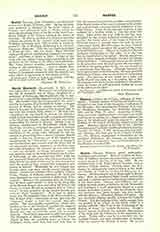

Harold Bluetooth (BLAATAND), b. 911; d. November 1, 985 or 986. He was the son of King Gorm the Old of Denmark and of Thyra, daughter of a nobleman of Schleswig (Søbnderjylland) who is supposed to have been kindly disposed towards Christianity. His mother must have implanted in the child’s soul the first germs of faith which his father, a devout servant of Wotan, did his utmost to destroy. The latter’s invasion of Friesland in 934 involved him in war with the German King, Henry I. Having been vanquished, he was forced to restore the churches which he had demolished as well as to grant toleration to his Christian subjects, and he died one year later, bequeathing his throne to Harold. Bishop Unni of Bremen, accompanied by Benedictine monks from the Abbey of Corvey, preached the gospel in Jutland (Jylland) and the Danish isles, and soon won the confidence of the young ruler, although he did not succeed in persuading him to receive baptism. Harold sought to shut the Germans out of his kingdom by strengthening the “Danawirk”—a series of ramparts and fortifications that existed until the latter half of the nineteenth century; moreover, as absolute quiet prevailed throughout the interior, he was even able to turn his thoughts to foreign enterprises. Again and again he came to the help of Richard the Fearless of Normandy (in the years 945 and 963), while his son conquered Semland and, after the assassination of King Harold Graafeld of Norway, he also managed to force the people of that country into temporary subjection to himself. Meanwhile the new religion had become more and more deeply rooted among the Danes. Even a few members of the nobility (such as Frode, Viceroy of Jutland) embraced the faith and soon episcopal sees were established (Schleswig, Ribe, Aarhus). However the prominent part the Germans had in these achievements as well as the lofty idea of the Roman Empire then prevailing led Otto I, the Great, to require Harold to recognize him as “advocatus”, or lord protector of the Danish church, and even as “Lord Paramount”. It is easy to understand why the indignant king of the Danes replied to this demand with a declaration of war, and why the “emperor” sought to force his “vassal” into subjection. The devastating expeditions, which were pushed as far as the Lymfjord, enabled the emperor to beat down all opposition (972), and to compel Harold not only to conclude peace but to accept baptism. Henceforth paganism steadily lost ground. The Bishopric of Odense was established at Funen (Fyen) in 980; the sacrificial grove at Lethra (on Zealand), which, until then, had been from time to time the scene of many human sacrifices, was deserted. King Harold removed his royal residence to Roeskilde and erected there a wooden church dedicated to the Holy Trinity. Later (in the eleventh century) it was replaced by a basilica which in turn was soon torn down. Since about the year 1200 its site has been occupied by the Gothic cathedral (dedicated to St. Lucius), the burial place of the kings of Denmark. Christian houses of worship were also built in many other places during Harold’s reign; in these German and Danish priests preached the gospel of the crucified and risen Savior. There is no doubt that Harold professed Christianity at that time: it is also true that he contributed to its spread. But his moral conduct in many respects distinctly violated the Divine commandments. Consequently many people looked on the plots that were directed against the sovereignty and life of the ageing prince by his own son (Svend) as a punishment from Heaven. Although baptized, the latter joined forces with Palnatoke, the most powerful chieftain on Fuhnen, who was the leader of the heathen party. The fortunes of war varied for a time, but finally Harold was slain on November 1, 985 or 986. His remains were buried in the cathedral at Roeskilde, where his bones are still preserved, walled up in one of the pillars of the choir.
PIUS WITTMANN

